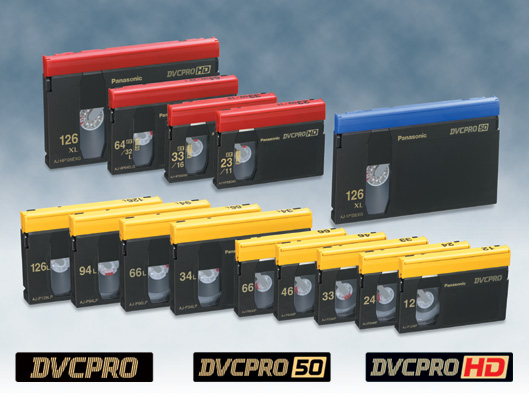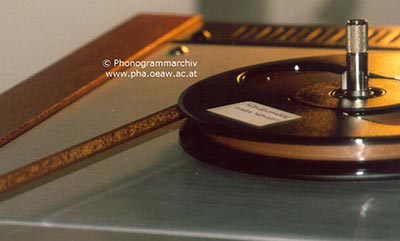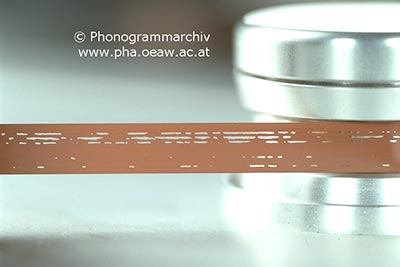| Table of Contents |
|---|
Introduction
| Table of Contents |
|---|
Introduction
...
DVCPRO is a professional-quality variation of the DV video recording specification introduced by Panasonic in 1995. DVCPRO also refers to video tape recorders and videocassettes that are designed to support these video recording specifications.
...
In 1997, an enhanced version of DVCPRO was brought to market. DVCPRO50 used two parallel DV codecs and featured a bitrate of 50 Mbps and a colour-sampling resolution of 4:2:2. This increased data rate reduced the recording time of DVCPRO50 by half, compared to standard DVCPRO. Panasonic also marketed a high definition DV format, which was made available in 2000. DVCPRO HD combined four parallel DV codecs, which increased the bitrate to 100 Mbps. A progressive scan version (DVCPRO P) was also developed to respond to the need for 525p images. Panasonic stopped selling videotape equipment in 2013.
Identification
...
| Info | ||
|---|---|---|
| ||
Preservation Self Assessment Program. "Videotape: DVCPRO." University of Illinois at Urbana-Champaign. Accessed February 3, 2021. |
| Info | ||
|---|---|---|
| ||
Image source: https://pro-av.panasonic.net/en/sales_o/02products/tapes/tapes.htmlDVCPRO Cassette Tape. Panasonic Corporation. Accessed February 23, 2021. |
Physical Characteristics
...
| Tape width | 1/4 inch |
|---|---|
| Tape composition | Metal particulate |
| Cassette dimensions | Large cassettes: 4 7/8" x 3" x 9/16" Medium cassettes: 3 13/16" x 2 1/2" x 9/16" |
| Container dimensions | Large cases: 5 1/4" x 3 5/16" x 3/4" Medium cases: 4 1/8" x 2 3/4" x 3/4" |
| Identifying features | Yellow anti-static cover: DVCPRO tapes Blue anti-static cover: DVCPRO50 tapes Red anti-static cover: DVCPRO HD tapes DVCPRO logo: upper right hand corner Tape length: left hand corner |
| Common manufacturers/brands | Panasonic, Maxell, Fuji |
| Playback | DVCPRO tapes can be played using DVCPRO and DVCAM VTRs DVCPRO VTRs can play DV, DVCAM and DVCPRO tapes |
...
| Version | DVCPRO | DVCPRO50 | DVCPRO HD |
|---|---|---|---|
| Record time | Large cassettes: up to 126 minutes Medium cassettes: up to 66 minutes | Large cassettes: up to 63 minutes Medium cassettes: up to 33 minutes | Large cassettes: up to 31 minutes Medium Cassettes: up to 16 minutes |
| Track pitch | 18 microns | 18 microns | Long play: 18 microns Short play: 9 microns |
| Track width | 18 microns | 18 microns | 18 microns |
| Record/playback speed | 33.82 mm/sec (1x) | 67.63 mm/sec (2x) | 135.28 mm/sec (4x) |
| Bitrate | 25 Mbit/s | 50 Mbit/s | 100 Mbit/s |
| Bit depth | 8 bit | 8 bit | 8 bit |
| Colour sampling | 4:1:1 | 4:2:2 | 4:2:2 |
| Resolution | NTSC: 720x480 PAL: 720x576 | NTSC: 720x480 PAL: 720x576 | Uses downsampling:
|
| Compression | 5:1 DCT compression | 3.3:1 DCT compression | 6.7:1 DCT compression |
...
| Panasonic DVCPRO Tape | DVCPRO | DVCPRO50 | DVCPROHD | DVCPROHD-LP | Tape Length |
|---|---|---|---|---|---|
| Model | Recording and playback times | (metres) | |||
| AJ0P12M (Medium Cassette) | 12 minutes | 6 minutes | 3 minutes | 6 minutes | 27 m |
| AJ-P24M (Medium Cassette) | 24 minutes | 12 minutes | 6 minutes | 12 minutes | 51 m |
| AJ-P33M (Medium Cassette) | 33 minutes | 16.5 minutes | 8 minutes | 16.5 minutes | 70 m |
| AJ-P46M (Medium Cassette) | 46 minutes | 23 minutes | 11.5 minutes | 23 minutes | 96 m |
| AJ-P66M (Medium Cassette) | 66 minutes | 33 minutes | 16.5 minutes | 33 minutes | 137 m |
| AJ-P34L (Large Cassette) | 32 minutes | 17 minutes | 8.5 minutes | 17 minutes | 72 m |
| AJ-P66L (Large Cassette) | 66 minutes | 33 minutes | 16.5 minutes | 33 minutes | 137 m |
| AJ-P94L (Large Cassette) | 94 minutes | 47 minutes | 23.5 minutes | 47 minutes | 194 m |
| AJ-P126L (Large Cassette) | 126 minutes | 63 minutes | 31.5 minutes | 63 minutes | 259 m |
| Info | ||
|---|---|---|
| ||
Panasonic DVCPro Compatibility & Interchangeability Recording & Playback Times/Application |
Technical standards
...
| Format | Standards |
|---|---|
| DVCPRO, DVCPRO 50 |
|
| DVCPRO HD |
|
...
| Storage environment: temperature | Ideal: 40–54°F (4.5–12°C) Acceptable: 55–60°F (13–15.5°C) |
|---|---|
| Storage environment: humidity | 30–50% RH |
| Container | DVCPRO containers should pass the Photographic Activity Test (PAT) as specified ISO Standard 18916:2007
Containers are acceptable if they:
Unacceptable containers must be replaced with clean, inert containers. |
| Orientation of tape in storage | Vertical on its end (like books) |
Types of damage and deterioration
...
Binder deterioration
| Info | ||
|---|---|---|
|
Binder deterioration
...
"1.1.3. Inspect for damage / Look for chemical deterioration / Binder degradation". In Audio Tape Digitisation Workflow. Accessed February 22, 2021. |
Description
Commonly known as "sticky shed syndrome." Affected records will have a visible gummy or powdery residue on the surface of the tape. This can damage both the recorded material and playback equipment. Back-coated tapes are most affected by this type of deterioration.
...
Baking: Holding the tape at an elevated temperature (45°C to 55°C) for a brief period of time (up to 36 hours) can temporarily remove moisture and allow normal playback for a period of one to two weeks. Tapes should not be rewound before baking.
Drop-out
https://www.musiikkiarkisto.fi/audio/audio113.html
| Info | ||
|---|---|---|
| ||
"1.1.3. Inspect for damage / Look for chemical deterioration / Binder degradation". In Audio Tape Digitisation Workflow. Accessed February 22, 2021. |
Description
A brief signal loss caused by a tape head clog, missing magnetic oxide particles, tape defect, or debris on the tape or machine. These factors can reduce head-to-tape spacing and result in the appearance of white spots or streaks on playback. Multiple drop-outs per frame will result in a snowy appearance.
...
Visit the /wiki/spaces/ALC/overview for further reading on /wiki/spaces/ALC/pages/1891631115.
References
...
AMIA. "Video Preservation Factsheets." Accessed December 10, 2020.
Bensinger, Charles. "Chapter 6: All about videotape." In The Video Guide, Second Edition, 71-75. Santa Barbara, California: Video-Info Publications, 1981.
Bogart, John Van. "What Can Go Wrong With Magnetic Media?" In Magnetic Tape Storage and Handling: A Guide for Libraries and Archives. Washington, DC: The Commission on Preservation and Access, 1995.
Casey, Mike. "FACET: Format characteristics and preservation problems." Bloomington, IN: Indiana University, 2007.
DigiMad. "Digital Video DV." Accessed February 2, 2021.
Gibson, Gerald. D. "Magnetic tape deterioration: recognition, recovery and prevention." Paper presented at the IASA Conference, Perugia, August 26, 1996.
MediaCollege.com. "The DVCPRO Video format." Accessed January 10, 2021.
MediaCollege.com. "The DVCPRO50 format." Accessed January 10, 2021.
MediaCollege.com. "The DVCPRO HD format." Accessed January 10, 2021.
Museum of Obsolete Media. "DVCPRO (1995 – early 2010s)." Accessed January 10, 2021.
Museum of Obsolete Media. "DVCPRO HD (2000 – early 2010s)." Accessed January 10, 2021.
Museum of Obsolete Media. "DVCPRO50 (1997 – early 2010s)." Accessed January 10, 2021.
Panasonic Canada Inc. "AJHD150 DVCPRO HD Studio VTR." Accessed January 10, 2021.
TapeOnline. "DVCPRO FAQ." January 10, 2021.
Jimenez, Mona and Liss Platt. "Videotape Identification and Assessment Guide." Texas Commission on the Arts. 2004.
Wheeler, Jim. "Videotape preservation handbook." 2002.
Wilt, Adam J. "The DV, DVCAM & DVCPRO Formats: The DV formats tabulated." August 28, 2005.
Version history
...
| Version | Date | Author(s) | Version Notes |
|---|---|---|---|



